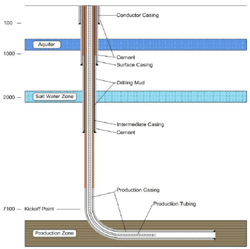Environmental Fracturing
Comparison of Environmental and Shale Gas Hydrofracturing
- Overview
- Comparison of Environmental and Shale Gas Hydrofracturing
- Guidance
- Application
- Additional Resources
Environmental hydrofracturing technologies have their theoretical underpinnings in the oil and gas exploration industries. While they have similarities, the oil and gas exploration hydrofracturing operations are much larger, use different equipment and chemicals, and operate at a much greater depth than environmental hydrofracturing technologies.
The approach to environmental hydrofracturing is generally to induce fracturing in vertical wells using a food grade water-based gel that is capable of carrying propping agents (coarse sand) and/or remediation amendments. The depth of treatment has rarely been below 100 feet with individual radii of influence from the fracturing well rarely exceeding 100 ft and typically being 20 to 35 feet. Because of the limited radius of influence, a number of wells may be required to encompass the targeted contaminant zone. Injection pressures used in environmental hydrofracturing typically are less than 1,000 psi for rock work, 100 psi for silt or clay.

![]()
Schematic of Horizontal Hydrofracturing Well (Source: Ground Water Protection Council and ALL Consulting 2009)
In contrast, shale gas hydrofracturing usually targets a gas bearing shale formation that lies 2,000 to 10,000 feet bgs, although some can be shallower. It consists of two major phases—drilling of the well, which may include a vertical and a horizon component, and the fracturing and gas recovery process.
If a horizontal well component is used, it follows the shale formation and can be 1,000 to greater than 5,000 feet long. Depending on the size of the shale formation, fractures made in the formation can extend to 1,000 or more feet away from the well component used for the development of the fractures. The drilling and hydraulic fracturing of a horizontal shale gas well may require 2 to 4 million gallons of water (or more), with about 3 million gallons being most common (Ground Water Protection Council and ALL Consulting 2009). Injection pressures can approach 8,000 psi (Arthur et al. 2009).
References:




